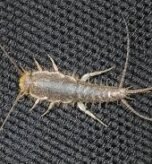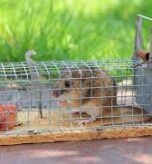Introduction to Mud Daubers
Mud daubers get their name from their distinctive nest-building material: mud. These wasps have a long, slender “thread-waisted” body, which is a narrow segment connecting the thorax and abdomen. Their coloration varies, commonly ranging from black and yellow to metallic blue or iridescent blue-black. Adult dirt daubers typically measure between ½ inch and 1 inch in length, with females generally larger than males.
Ecological Role and Benefits
Mud daubers play a significant role in the ecosystem, primarily as natural predators of spiders. They are particularly adept at hunting and paralyzing various spider species, including venomous ones like black widows. The paralyzed spiders serve as a food source for their larvae inside the mud cells. Additionally, adult mud daubers contribute to pollination by feeding on plant nectar and honeydew.
Mud Dauber Nest Characteristics
Female mud daubers are the sole architects of their nests.The nest architecture varies by species:
• Organ Pipe Mud Daubers build distinctive cylindrical tubes that resemble organ pipes or pan flutes.
• Mud Daubers create more globular or cigar-shaped clusters of one to several cells
The female provisions each nest cell with paralyzed spiders and a single egg, which feeds the larva upon hatching. Once she seals the cell, the female leaves the nest and does not return.
Common Nesting Locations
Mud daubers typically build their nests in sheltered, protected areas away from the elements. They commonly place them in:
- The eaves of buildings
- Porches and sheds
- Attics and garages
- Unused chimneys or flues
- The spaces between walls or under floorboards
- The crevices of rocks and trees
Distinguishing from Other Wasp Nests
Mud dauber nests are generally small, typically 1-2 inches in diameter, and made entirely of mud, which can have a smooth or rough texture. A key indicator of an inactive or abandoned nest is the presence of a round exit hole, signifying that the adult wasp has emerged, usually after spring. This differentiates them from the paper-like nests of social wasps, which are typically larger and may have multiple exposed cells.
Assessing the Impact of Mud Dauber Nests
Sting Risk and Venom Potency
Mud daubers are widely considered non-aggressive and pose a minimal threat to humans. They rarely sting unless you directly provoke or handle them, or accidentally trap one in your clothing. Their venom is primarily for paralyzing spiders, not for self-defense against larger threats like humans. As a result, a sting is typically mild and short-lived, resembling a common bug bite with localized pain, swelling, or itching. It’s important to remember that male mud daubers don’t have stingers.
However, if you have a pre-existing allergy to wasp venom, you may experience a severe systemic reaction known as anphylaxis. Anaphylaxis symptoms can include difficulty breathing, swelling of the face, mouth, or throat, hives, dizziness, or loss of consciousness, and require immediate emergency medical attention. Those at risk should carry prescribed adrenaline auto-injectors (AAIs) and know how to use them. Even without an allergy, multiple stings can lead to problematic symptoms such as nausea, dizziness, fainting, or seizures, which warrant medical consultation.
Property Concerns
Mud dauber nests typically don’t cause structural damage to your property. Their primary inconvenience is that they are unsightly and, in some cases, cause minor issues like surface staining or blocking vents. A significant concern arises when more aggressive wasp species, like paper wasps, take over abandoned mud dauber nests. These wasps will defend the nest aggressively.
When Coexistence is Recommended
Given their beneficial role in controlling spider populations and their non-aggressive nature, it is often advisable to leave mud dauber nests undisturbed if they are not in high-traffic areas or accessible to children or pets, and are not actively causing a nuisance. Many homeowners can coexist with mud daubers without incident due to their solitary habits and tendency to avoid humans.
Comprehensive Strategies for Nest Management and Prevention
When mud dauber nests are problematic due to location or appearance, removal may be necessary. Safety and timing are crucial for effective and low-risk intervention.
Safe Nest Removal Techniques
You can physically remove nests by scraping them off surfaces with a putty knife, stick, or knife. For newer or more stubborn nests, you can hose them off with water or use a power washer to soften the mud for easier removal. If you find nests inside your home, you can use a vacuum to remove the wasps and nests, but you must properly seal and dispose of the bag to prevent them from getting back onto your property.
• Timing Considerations: The optimal time for nest removal is in the late evening when mud daubers are inactive. Alternatively, removal can be performed during winter when the wasps are dormant. Nests with round exit holes indicate that the wasps have already emerged, signifying an abandoned structure that can be safely removed and discarded.
• Post-Removal Cleanup: After detaching the main nest, scrub the area with warm, soapy water and a cloth or sponge to remove any residual dirt. Using a scrub brush with plastic bristles is recommended, while metal brushes should be avoided to prevent surface damage. This step also helps deter future nesting in the same spot.
Preventive Measures
To discourage mud daubers from nesting on your property:
• Habitat Modification:
◦ Reduce food sources by regularly cleaning up spider webs and other insects around your home.
◦ Seal cracks, gaps, and crevices in exterior walls, especially around windows and doors, and ensure all windows have screens to prevent entry.
• Deterrents:
◦ Natural repellents such as essential oils (peppermint, chamomile, cinnamon, tea tree, lavender) diluted in water, or white vinegar and citrus oil sprays, can be applied to deter wasps. Reapplication is necessary as the scent fades.
◦ Growing herbs like eucalyptus, thyme, wormwood, citronella, or spearmint in your garden can also naturally repel them.
◦ Painting exterior walls or porch ceilings blue may also be effective, as wasps tend to avoid this color because it resembles the sky.
◦ Attracting birds that prey on mud daubers by putting out bird seed can also help control their population.
• Chemical Control:
◦ Applying a residual insecticide to areas prone to nesting (e.g., under eaves, in crevices) can deter mud daubers.
◦ When using any insecticide, it is paramount to research the product thoroughly, ensure it is safe for your environment, and strictly adhere to all instructions and precautions on the packaging, especially concerning children and pets.
◦ It is important not to squash a wasp, as this can release a pheromone that attracts other wasps to the area.
Importance of Professional Assistance
While mud daubers are generally docile, contacting a pest control professional is highly recommended if nests are in hard-to-reach locations, if you are uncomfortable with self-removal due to the inherent risk of being stung, or if there’s a possibility that more aggressive wasp species have taken over an abandoned mud dauber nest. Professionals can ensure safe and effective removal and provide tailored prevention plans.
Conclusion
Mud daubers, though capable of building unsightly nests, are largely benign and offer significant ecological benefits through spider control. Understanding their behavior and lifecycle allows for informed decisions regarding their presence. Whether choosing to coexist with these beneficial insects or to implement removal and prevention strategies, prioritizing safety and, when necessary, seeking expert assistance ensures effective management while minimizing risks to humans and property.



